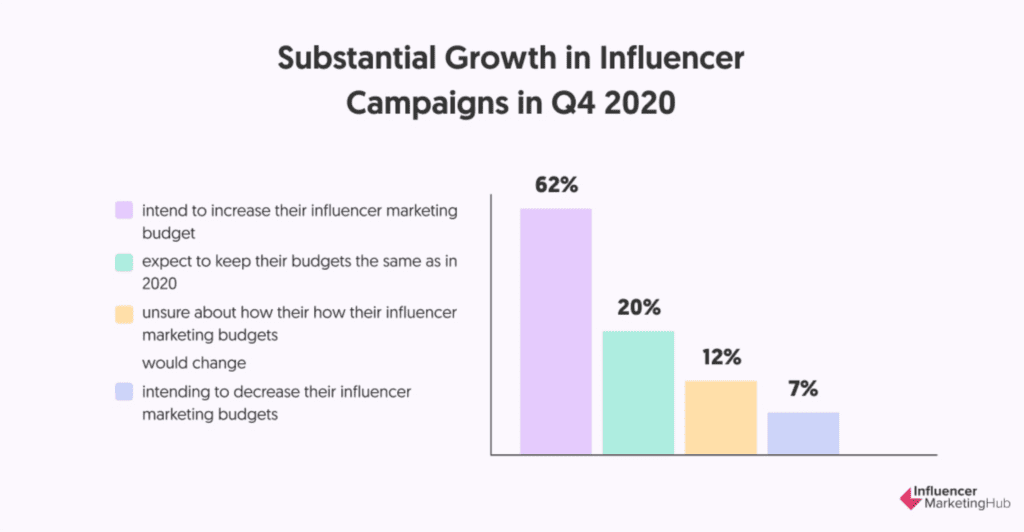Since the introduction of influencer marketing to the world of business, it has been viewed as one of the most efficient and inexpensive ways for brands to drive awareness and expand their audience. In this article We’ll talk about the value of influencer marketing for brands and companies.
The concept of using trusted personalities with a large following to promote a brand made perfect sense and seemed to be an almost foolproof strategy to gain brand awareness.
This was when social media personalities started appearing on every platform and brands treated them as internet celebrities they could leverage to promote to a young audience.
But as influencer marketing evolved, it has become more complex and more expensive.
Now there are millions of influencers.
There are nano, micro, mid-tier, macro, mega and celebrity influencers. All with unique personalities and audiences.
Below, you will find everything you need to know about the current state of influencer marketing. Current challenges as well as the best ways to get the most out of influencer marketing in 2022 and beyond.
The value of the influencer marketing industry
Let’s take a look at the current state of the influencer marketing industry.
The influencer marketing industry is rapidly growing. In fact, it was valued as a $13.8 billion industry in 2021.
We can see this growth in the decisions companies are making these days. For example, brands are increasing their influencer marketing budget every year:

There is a reason why marketers are doing this. And it’s because influencers are effective, if you choose the right ones.
But are they as effective as other marketing channels?
Yes. Almost 90% of marketers say that ROI from influencer marketing is comparable or even better than other channels.
Recommended: Influencer Marketing: The Ultimate Guide for 2022
Challenges of influencer marketing
But not everything is perfect in the world of influencers. There are challenges that brands have to be aware of in order to overcome them. These are the most significant in 2022:
Oversaturation
One of the most prominent issues within influencer marketing is oversaturation.
Now that there are so many categories for influencers, there are too many options and it’s difficult to choose the right ones.
Companies have to do their research and think about their goals before paying an influencer.
Why is the market oversaturated?
Being paid to post to social media has become the new “American dream” for many people.
So as the trend keeps growing, a lot of people are attempting to capitalize on it.
There are far too many accounts trying to gain influencer status. Some want it so badly that they commit influencer fraud. More on that later.
The main problem for oversaturation is that many influencers may have the follower count to support their status, but lack the key trait that is essential to securing returns on investment for a brand — actual influence.
Someone can have millions of followers, but if his or her audience is not actively interacting and engaging, your campaign will most likely suffer.
The value of influencer marketing relies on the credibility and relationship that influencers have with their audience.
This has caused brands to shift their focus to micro and nano influencers, because consumers trust opinions and recommendations from sources they deem personal and authentic.
And it shows. Small influencers have better engagement rates than mega/celebrity influencers.
Using smaller influencers with a few thousand followers to promote brands is the new wave for influencer marketing. This strategy will continue to grow as companies realize that it actually works and has a better ROI than hiring superstar influencers considering how much they charge.
Influencer fraud
We’ve said it before and we will say it again. High follower counts don’t mean high engagement rates.
Far too many Instagram accounts have inflated follower numbers when compared to the actual reach they offer.
These inflated follower counts could be considered “empty calories” with high percentages of the follower accounts being inactive, un-engaged, or simply being paid bots.
All of which are worthless to a brand that is trying to generate a thriving and authentic online community.
However, inactive followers aren’t technically fraud, but paid followers and bots are.
Many people figured out that a lot of brands hired influencers just by looking at their follower count. Influencer marketing was new to many brands and they just thought, “it couldn’t hurt to pay someone with this many followers for promotion”.
Well, cybersecurity firm Cheq estimates that businesses lost 1.3 billion dollars to influencer fraud in 2019.
This is something that is still happening because social media numbers can be misleading without the proper research.
So it’s imperative that when laying out your influencer marketing strategy, you’re able to identify the right influencers to get significant value out of your investment.
Avoiding influencer fraud
While many companies develop relationships directly with their individual influencers, the landscape of influencer marketing has shifted and now there are other options. For example, agencies, where they manage the influencers for brands.
This system reduces the risk of losing an investment with unreliable personalities.
However, the problem with agencies is that you have less control over your influencers and the relationship isn’t as close as it could be.
To avoid influencer fraud and still select and manage influencers yourself you just need to do a thorough analysis of the candidates.
Here are some of the things you should be careful about:
- Recently created accounts with tons of followers, but very little engagement
- Unusual spikes in followers or engagement soon after a post
- Generic comments that have nothing to do with the post
These indicatator will help you know if someone is inflating their numbers through unethical practices.
What will influencer marketing look like beyond 2025?
Despite influencer fraud and oversaturation, there is still a lot of value to be found in influencer marketing.
But like all forms of advertisement, it should be conducted with focus, strategy, and efficiency.
In 2022 we can see that smaller influencers are rising in popularity because consumers nowadays are becoming more skeptical of traditional advertising.
Consumers, especially Gen Z, gravitate towards brands that offer a genuine relationship based on honesty.
Nano and micro influencers are perfect for this task because they are perceived to be more genuine and authentic than larger influencers.
The most authentic way to get people to talk about your brand is to invest in your community.
By focusing less on follower count and more on the relationship they have with their audience, the increased ROI will follow naturally.
This strategy will continue to grow in the coming years.
But now that people with relatively small follower counts can be hired by brands, it can be easier to get status and trick brands into paying.
Influencer management tools
In 2022 we can expect brands to start using smart influencer management tools to avoid the risk of being scammed as well as for tracking campaign performance.
With SocialLadder marketing teams can, among other things:
- Find influencers of any size
- Have streamline communication
- Assign tasks
- Automate rewards and payments
- Track performance
In addition, SocialLadder has unique features for brands to manage nano and micro influencers like no other platform. Want to know more about SocialLadder?



